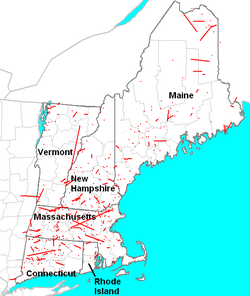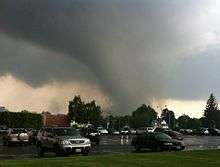Tornadoes in New England
Tornadoes are fairly uncommon in the US region of New England. Fewer tornadoes are recorded here than anywhere else east of the Rocky Mountains.[1] However, these deadly and destructive storms do occur; on average, about eight tornadoes are reported in the region each year. Almost 200 people have been killed by these storms in recorded history, and two of the ten most destructive tornadoes in US history occurred in this region.

Climatology
| State | Per year | By area† |
|---|---|---|
| Connecticut | 1.5 | 2.8 |
| Maine | 1.9 | 0.5 |
| Massachusetts | 2.5 | 2.4 |
| New Hampshire | 1.5 | 1.6 |
| Rhode Island | 0.2 | 1.1 |
| Vermont | 0.7 | 0.7 |
| National Climatic Data Center,[2] US Census Bureau †Avg. number tornadoes per year per 10,000 square miles (26,000 km2) | ||
Tornadoes are a violent weather phenomenon that occur most often in the United States, to the east of the Rocky Mountains. However, they most often occur in the Southern and Central United States, and are comparatively rare in New England. However, no region is immune to tornadoes if the weather conditions are right.[3]
While tornadoes have been recorded in almost every county in New England, there is a region just east of The Berkshires with a much higher concentration of tornado occurrences. This area is analogous to the Tornado Alley of the Great Plains, but on a much smaller scale.[1][2]
On average (1950–2008), more than two tornadoes per year strike the state of Massachusetts alone, with New England as a whole recording more than 8.[1][2] Most tornadoes reported in the region are "weak", rated EF0 or EF1 on the Enhanced Fujita Scale (the Fujita scale prior to 2007). Around 30% are "significant" tornadoes (rated EF2 or greater), and only 1% are violent (rated EF4 or EF5, the highest damage rating). Weak tornadoes occur in all areas of New England, but EF3 or greater tornadoes have been reported only in New England's practical "Tornado Alley" of Massachusetts, Connecticut, and southern New Hampshire.[2]
Peak tornado activity in New England occurs during the summer months of June, July and August. Tornadoes typically strike between 3 and 9 pm local time, and move at a forward speed of around 30 miles per hour (48 km/h).[4]
Notable tornadoes
Deadliest
There have been 34 killer tornadoes in New England's recorded history:[2][5]
- August 15, 1787: The Four-State Tornado Swarm caused damage in Connecticut, Rhode Island, Massachusetts, and New Hampshire. Two people were killed by a tornado in Wethersfield, Connecticut, and many were injured throughout New England.[6]
- September 9, 1821: Several tornadoes struck northern and central New England, including the Great New Hampshire Tornado, which killed 6 people in New Hampshire, and another which killed two people in Massachusetts.[7]
- August 9, 1878: A violent tornado killed either 29 or 34 people in Wallingford, Connecticut.[8]
- July 16, 1879: Two people were killed by a tornado in Pittsfield, Massachusetts.[9]
- July 26, 1890: A tornado killed eight people in Lawrence, Massachusetts.[10]
- July 4, 1898: A tornado struck Hampton Beach, New Hampshire, a popular resort town. More than 100 people sought refuge in the skating rink, and three people were killed and 120 injured when the roof collapsed. Twenty cottages were also destroyed. A yacht was overturned by the storm, drowning five people, but it is unclear whether this was due to the tornado.[11]
- June 9, 1953: The 1953 Worcester tornado killed 94 people as it damaged or destroyed thousands of homes in central Massachusetts, including the city of Worcester.[12]
- August 28, 1973: A tornado touched down near Canaan, New York, and moved into western Massachusetts. Three people were killed in West Stockbridge when a truck stop was completely destroyed, and another person died in a destroyed house nearby.[13][14]

- August 10, 1979: A tornado struck a boy scout camp in Paxton, Massachusetts, downing trees and killing two scouts.[15]
- October 3, 1979: A violent tornado killed three people in Windsor Locks, Connecticut.[16]
- May 29, 1995: A violent tornado killed three people in Great Barrington, Massachusetts and the surrounding area.[17]
- June 1, 2011: A strong tornado killed three people in western Massachusetts, striking downtown Springfield.[18][19]
Only two tornadoes in the history of New England have killed more than 10 people: the 1953 Worcester Tornado and the 1878 Wallingford tornado. The Worcester Tornado killed as many as 94 people in Worcester, Massachusetts, on June 9, 1953, and the Wallingford Tornado killed as many as 34 in Wallingford, Connecticut, on August 8, 1878. These two tornadoes, both estimated to be of F4 intensity on the Fujita scale, killed more people than the rest of the tornadoes in the region's recorded history combined. Since most New England tornadoes are weak and short-lived, it is understandable why tornadoes causing fatalities are a rare occurrence.
Costliest
Of the costliest tornadoes in US history (adjusted for inflation), two occurred in New England: The 1979 Windsor Locks, Connecticut tornado, which caused $200 million in damage ($705 million in 2020 USD), and the 1953 Worcester tornado, which caused $52 million in damage ($497 million in 2020 USD).[20] The Worcester tornado damaged or destroyed thousands of homes over a wide swath of central Massachusetts; the Windsor Locks tornado by contrast had a relatively small damage path, but it caused significant damage to parts of Bradley International Airport, including the New England Air Museum, where dozens of expensive and historic aircraft were damaged or destroyed, leading to the large damage figure.[21]
See also
- Ten costliest US tornadoes
- List of Connecticut tornadoes
- List of Rhode Island tornadoes
References
- Zielinski and Keim, p. 200
- "NCDC Storm Events". National Climatic Data Center. 2008. Archived from the original on April 17, 2006. Retrieved May 13, 2008.
- Pete Spotts (June 2, 2011). "Massachusetts tornado: What are deadly tornadoes doing way up in New England?". Christian Science Monitor. Retrieved July 4, 2011.
- "Severe Weather Awareness - Tornadoes". Gray, Maine: National Weather Service. May 5, 2011. Retrieved July 4, 2011.
- Grazulis, pgs 379, 552–606
- Grazulis, pg. 553
- Grazulis, pg. 556
- Grazulis, pg. 596
- Grazulis, pg. 605
- Grazulis, pg. 653
- Grazulis, pg. 684
- Grazulis, pg. 974
- Grazulis, pg. 1144
- "Tornado Kills 4, Injures 31 Along Berkshire State Line". Schenectady Gazette. Schenectady, New York. August 29, 1973. p. 1. Retrieved June 16, 2011.
- Grazulis, pg. 1215
- Grazulis, pg. 1216
- Lance F. Bosart; Kenneth LaPenta; Anton Seimon & Michael Dickinson. "Terrain-Influenced Tornadogenesis in the Northeastern United States: An Examination of the 29 May 1995 Great Barrington, Massachusetts, Tornado" (PDF). Hyannis, Massachusetts: 22nd Conference on Severe Local Storms. Retrieved June 20, 2011.
- "Annual Fatal Tornado Summaries". Storm Prediction Center. National Oceanic and Atmospheric Administration. 2011. Retrieved June 20, 2011.
- Vivian Yee (June 18, 2011). "Insurance claims for tornadoes hit $140m". The Boston Globe. Archived from the original on April 6, 2012. Retrieved June 20, 2011.
- Brooks, Harold E.; Doswell, Charles A., III (February 2001). "Normalized Damage from Major Tornadoes in the United States: 1890–1999". Weather and Forecasting. Boston, Massachusetts: American Meteorological Society. 16 (1): 168–176. Bibcode:2001WtFor..16..168B. doi:10.1175/1520-0434(2001)016<0168:NDFMTI>2.0.CO;2.
- "Tornado!". Windsor Locks, Connecticut: New England Air Museum. Archived from the original on July 10, 1998. Retrieved June 15, 2011.
Book References
- Grazulis, Thomas P (July 1993). Significant Tornadoes 1680–1991. St. Johnsbury, VT: The Tornado Project of Environmental Films. ISBN 1-879362-03-1.
- Zielinski, Gregory A.; Keim, Barry D. (2003). New England Weather, New England Climate. Hanover and London: University Press of New England. ISBN 1-58465-312-4.
- Historic Storms of New England (Internet Archive)